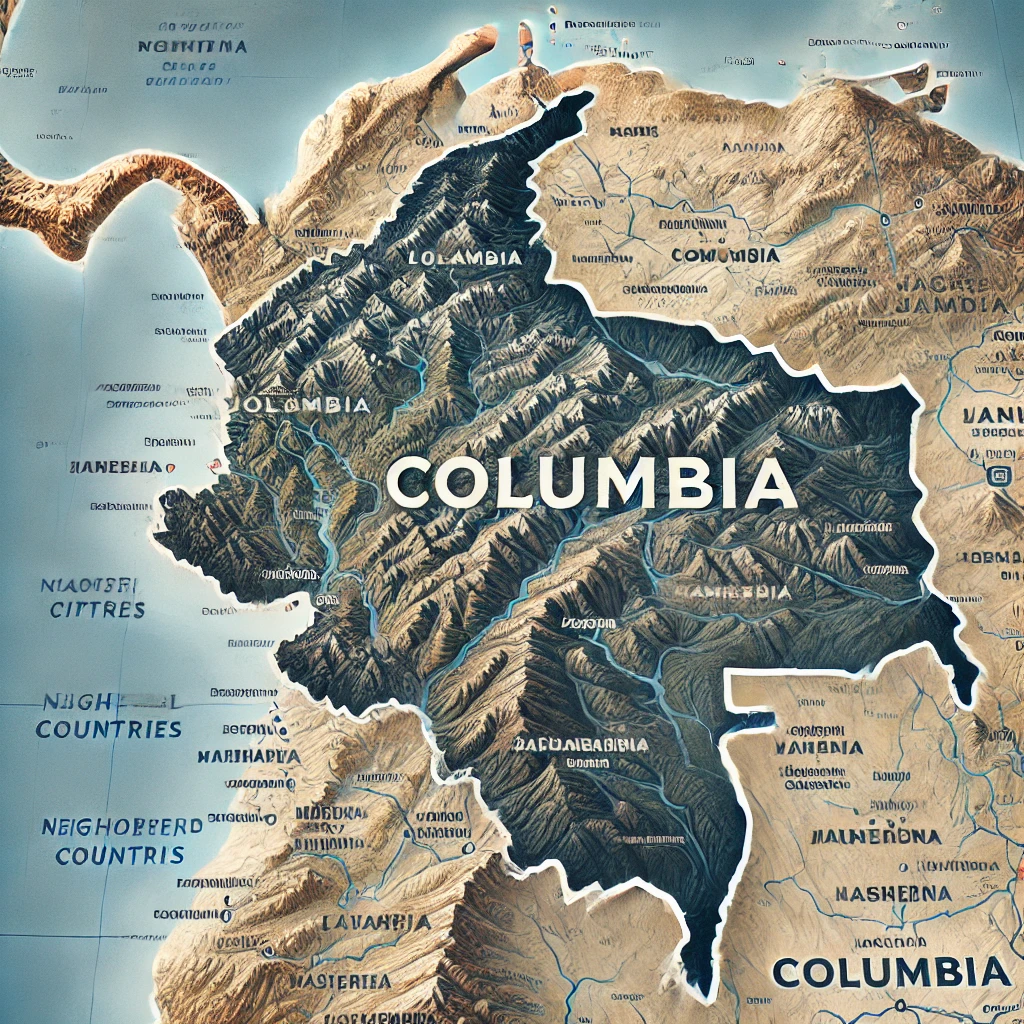Table of Contents
Map:8dncedo0phu= Columbia, located in the northwest corner of South America, is a country of striking natural beauty, diverse cultures, and complex geography. From its rugged Andean peaks to its lush Amazon rainforest, Columbia offers a vibrant mix of landscapes that has played a key role in shaping its history and culture.
Map:8dncedo0phu= Columbia The Andean Highlands: Columbia’s Backbone
Map:8dncedo0phu= Columbia One of the most defining features of Columbia is the Andes mountain range, which divides the country into three distinct ranges. Map:8dncedo0phu= Columbia The Central, Western, and Eastern Cordilleras form the spine of the country, shaping its climate, economy, and population distribution. The highlands are home to cities such as Bogotá, Medellín, and Cali, where most of the country’s urban population resides. Map:8dncedo0phu= Columbia
Bogotá: The Heart of Columbia

Map:8dncedo0phu= Columbia Bogotá, the capital of Columbia, is situated in the Andean highlands at an elevation of over 8,000 feet. It is the cultural, political, and economic hub of the country, known for its rich history and vibrant arts scene. The city’s unique combination of colonial and modern architecture reflects its dynamic past and present. Map:8dncedo0phu= Columbia
Medellín: The City of Eternal Spring
Map:8dncedo0phu= Columbia Nestled in a narrow valley in the Andes, Medellín is often referred to as the “City of Eternal Spring” due to its pleasant year-round weather. Once plagued by violence, the city has undergone an impressive transformation and is now a center for innovation and culture in Columbia.
Cali: The Salsa Capital of the World
Cali, located in the southwestern part of Columbia, is known for its Afro-Colombian culture and its lively salsa music and dance scene. The city’s tropical climate and vibrant nightlife make it a popular destination for both locals and tourists alike.
The Amazon Basin: Columbia’s Lungs
Map:8dncedo0phu= Columbia The southeastern part of Columbia is covered by the vast Amazon rainforest, a region of unparalleled biodiversity. This area, often referred to as the “lungs of the world,” is home to thousands of species of plants, animals, and indigenous communities who have lived in harmony with the forest for centuries. Map:8dncedo0phu= Columbia
The Orinoco Plains: A Sea of Grass
Map:8dncedo0phu= Columbia To the east of the Andes lies the Orinoco River basin, a vast plain known as the Llanos. This region is characterized by its open grasslands and rich wildlife, including jaguars, anacondas, and capybaras. The Llanos is a vital agricultural and cattle-ranching area, contributing significantly to the country’s economy.
The Caribbean Coast: A Cultural Melting Pot
Map:8dncedo0phu= Columbia Columbia’s Caribbean coast is a melting pot of African, indigenous, and European influences. Cities like Cartagena and Barranquilla boast stunning colonial architecture, beautiful beaches, and a rich cultural heritage. The region’s music, food, and festivals are a vibrant expression of Columbia’s multicultural identity.
Cartagena: A Jewel of the Caribbean
Cartagena is one of Columbia’s most visited cities, famous for its well-preserved colonial architecture and historical significance. As a UNESCO World Heritage site, it offers a glimpse into the country’s past, while also being a thriving port city with a bustling tourism industry.
Barranquilla: The Home of Carnival
Barranquilla, located on the Caribbean coast, is best known for its annual Carnival, one of the largest and most colorful festivals in Latin America. This celebration of music, dance, and cultural heritage draws visitors from around the world and showcases the vibrant spirit of the Colombian people.
The Pacific Coast: A Hidden Gem
Columbia’s Pacific coast is one of the most biodiverse regions in the world, yet it remains relatively undeveloped and undiscovered by tourists. The dense rainforests, remote beaches, and abundant wildlife make it a paradise for nature lovers and adventurers.
The Magdalena River: Columbia’s Lifeline
The Magdalena River, the country’s longest river, runs from the Andes to the Caribbean Sea and has historically been a major transportation route. It plays a crucial role in connecting the interior of Columbia with the coastal regions and has been a lifeline for trade and communication for centuries.
San Andrés and Providencia: Caribbean Islands
Off the coast of Columbia, the islands of San Andrés and Providencia are known for their crystal-clear waters, coral reefs, and laid-back island culture. These islands, though geographically closer to Central America, are a popular destination for Colombians seeking a tropical getaway.
Columbia’s Coffee Region: A World Heritage Site
The Coffee Cultural Landscape of Columbia, located in the western Andes, is a UNESCO World Heritage site. This region is famous for producing some of the best coffee in the world, and its picturesque coffee plantations are a testament to the country’s agricultural heritage.
The Guajira Peninsula: A Desert Oasis
In the far north of Columbia lies the Guajira Peninsula, a stark contrast to the lush rainforests and fertile valleys found elsewhere in the country. This arid region is home to the indigenous Wayuu people and offers stunning desert landscapes, including the impressive sand dunes of Taroa.
Columbia’s Biodiversity: A Global Treasure
Columbia is one of the most biodiverse countries on the planet, with more species of birds, amphibians, and orchids than any other country. This incredible biodiversity is a result of the country’s varied climates and ecosystems, from tropical rainforests to high-altitude páramos.
Climate and Ecosystems: A Diverse Range
The diverse geography of Columbia creates a wide range of climates and ecosystems. From the tropical heat of the Amazon and Caribbean coast to the cool, temperate climate of the Andean highlands, Columbia’s varied environments support an astonishing array of plant and animal life.
Indigenous Communities: Guardians of Tradition
Many indigenous communities in Columbia have maintained their traditional ways of life despite centuries of colonization and modernization. These communities, particularly in the Amazon and Sierra Nevada de Santa Marta, continue to play a vital role in preserving Columbia’s cultural and environmental heritage.
Columbia’s National Parks: Protecting Nature
Columbia is home to over 50 national parks, which protect its unique landscapes and wildlife. From the snow-capped peaks of the Sierra Nevada del Cocuy to the tropical beaches of Tayrona National Park, these protected areas offer visitors a chance to experience Columbia’s natural beauty.
Tayrona National Park: A Coastal Paradise
Tayrona National Park, located on the Caribbean coast, is one of Columbia’s most popular destinations. With its stunning beaches, lush rainforest, and rich cultural history, it is a must-visit for anyone exploring Columbia’s natural wonders.
Sierra Nevada de Santa Marta: The World’s Tallest Coastal Range
The Sierra Nevada de Santa Marta is the world’s tallest coastal mountain range, with peaks reaching over 18,000 feet. This isolated region is home to indigenous tribes and a rich diversity of wildlife, and it remains one of the most ecologically important areas in Columbia.
Columbia’s Future: Balancing Development and Conservation
As Columbia continues to develop economically, it faces the challenge of balancing growth with environmental conservation. The country’s rich natural resources, coupled with its commitment to sustainability, offer hope for a future where economic development and environmental protection go hand in hand.







